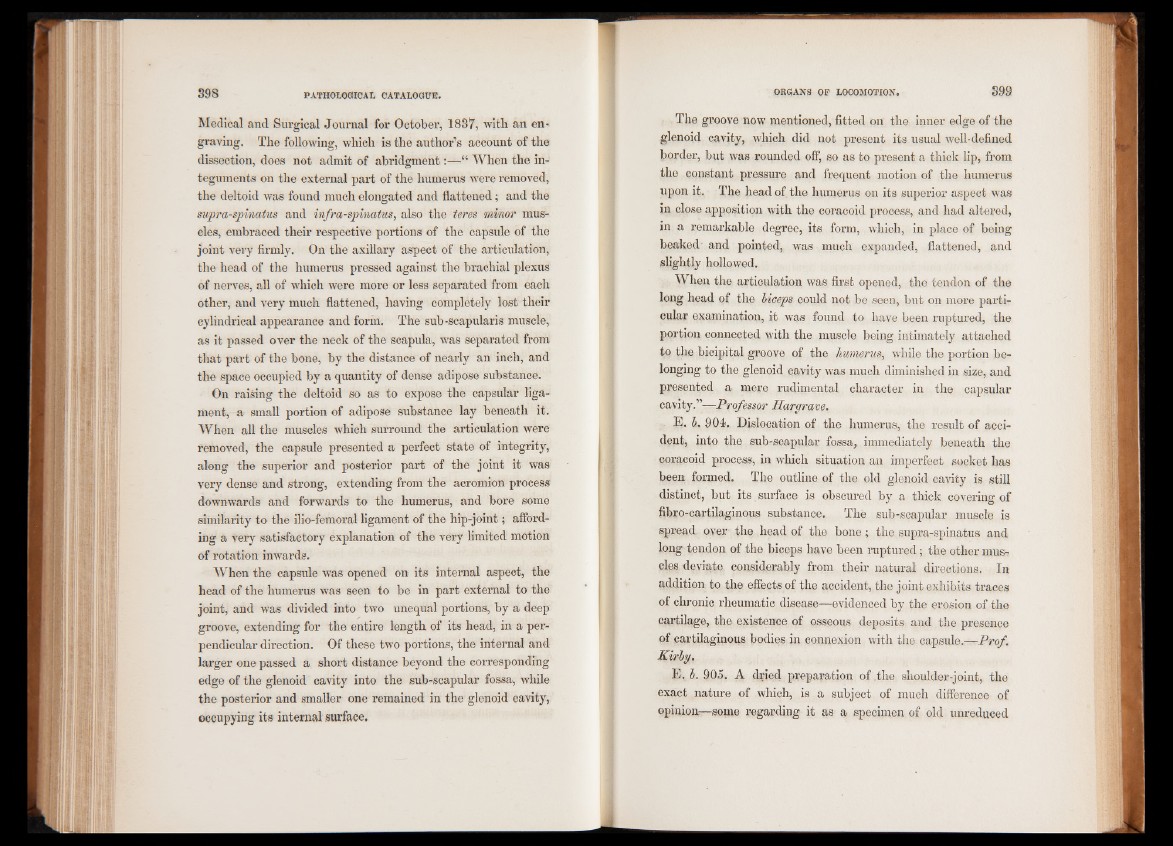
Medical and Surgical Journal for October, 1837, with an engraving.
The following, which is the author’s account of the
dissection, does not admit of abridgment:—“ When the integuments
on the external part of the humerus were removed,
the deltoid was found much elongated and flattened; and the
supraspinatus and infraspinatus, also the teres minor muscles,
embraced their respective portions of the capsule of the
joint very firmly. On the axillary aspect of the articulation,
the head of the humerus pressed against the brachial plexus
of nerves, all of which were more or less separated from each
other, and very much flattened, having completely lost their
cylindrical appearance and form. The sub-scapularis muscle,
as it passed over the neck of the scapula, was separated from
that part of the bone, by the distance of nearly an inch, and
the space occupied by a quantity of dense adipose substance.
On raising the deltoid so as to expose the capsular ligament,
a small portion of adipose substance lay beneath it.
When all the muscles which surround the articulation were
removed, the capsule presented a perfect state of integrity,
along the superior and posterior part of the joint it was
very dense and strong, extending from the acromion process
downwards and forwards to the humerus, and bore some
similarity to the ilio-femoral ligament of the hip-joint; affording
a very satisfactory explanation of the very limited motion
of rotation inwards.
When the capsule was opened on its internal aspect, the
head of the humerus was seen to be in part external to the
joint, and was divided into two unequal portions, by a deep
groove, extending for the entire length of its head, in a perpendicular
direction. Of these two portions, the internal and
larger one passed a short distance beyond the corresponding
edge of the glenoid cavity into the sub-scapular fossa, while
the posterior and smaller one remained in the glenoid cavity,
occupying its internal surface.
The groove now mentioned, fitted on the inner edge of the
glenoid cavity, which did not present its usual well-defined
border, but was rounded off, so as to present a thick lip, from
the constant pressure and frequent motion of the humerus
upon it. The head of. the humerus on its superior aspect wTas
in close apposition with the coracoid process, and had altered,
in a remarkable degree, its form, which, in place of being
beaked and pointed, was much expanded, flattened, and
slightly hollowed.
When the articulation was first opened, the tendon of the
long head of the biceps could not be seen, but on more particular
examination, it was found to have been ruptured, the
portion connected with the muscle being intimately attached
to the bicipital groove of the humerus, while the portion belonging
to the glenoid cavity was much diminished in size, and
presented a mere rudimental character in the capsular
cavity.”—Professor Hargrave.
E. b. 904, Dislocation of the humerus, the result of accident,
into the sub-scapular fossa, immediately beneath the
coracoid process, in which situation an imperfect socket has
been formed. The outline of the old glenoid cavity is still
distinct, but its surface is obscured by a thick covering of
fibro-cartilaginous substance. The sub-scapular muscle is
spread over the head of the bone; the supra-spinatus and
long tendon of the biceps have been ruptured; the other muscles
deviate considerably from their natural directions. In
addition to the effects of the accident, the joint exhibits traces
of chronic rheumatic disease—evidenced by the erosion of the
cartilage, the existence of osseous deposits and the presence
of cartilaginous bodies in connexion with the capsule.—Prof.
Kirby.
E. b. 905. A dried preparation of the shoulder-joint, the
exact nature of which, is a subject of much difference of
opinion—some regarding it as a specimen of old unreduced